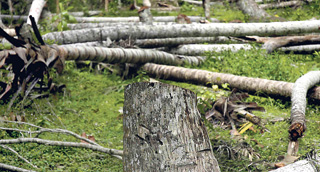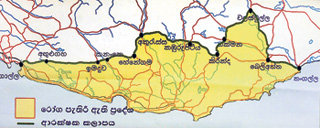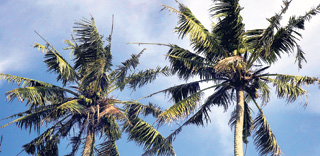Agriculture officials are on high alert in the south over the spread of a disease affecting coconut trees .
The coconut leaf wilt/ rot disease found in several areas in the southern part of the country was first reported in 2000 in Weligama. It is caused by a micro-organism known as Phytoplasma, which was identified in 2008, the Sunday Times learns.
Head of the Technological Transfers Division of the Coconut Research Institute (CRI) Henry Nimal Appuhamy said thatso far, the coconut leaf wilt disease is found only in the south, and has not been recorded in any other part of the island.
Following the detection of the cause of the disease, the Coconut Cultivation Board (CCB) launched a project in May 2008 to control its spread by the removal of the affected trees, creating awareness and strengthening vigilance to prevent plant material being transported to other parts of the country etc.
Identifying the disease is difficult, officials say, especially at its initial stages until the symptoms show up in the yellowing of leaf, or in the leaf turning inward like ribs in the chest. The disease can linger in the tree for years resulting in a gradual decline in production but may not kill the tree.
In an 18-acre coconut plantation in Uyangodawatte, Ahangama, the Sunday Times met manager T. Nanayakkara, who informed us that 104 trees in his estate had to be removed due to the wilt. “We couldn’t identify the disease, but we realised that there was a marked drop in the production. Usually we would get about 6000 nuts for a season, but gradually we noticed a reduction of about 1500 coconuts each season,” he said.
In Ajith Priyantha’s property in Andugoda, 20 trees have been marked for removal. He too said he didn’t identify the disease until the CCB officials who came to inspect his land informed him of it.
CCB Project Officer R.A.P Mahilal who is handling the Weligama Coconut Wilt Disease Management project said the project to combat the disease was launched on the instructions of the Coconut Research Institute. Under this an affected area and a buffer zone have been declared.
The number of trees affected by the coconut wilt disease both in the buffer zone and the affected areas has been estimated at 25,1980 in Matara, 65,878 in Galle, and 14,344 in Hambantota.
A CCB survey was done in the buffer zone where 44, 536 properties (an extent of 32, 728 acres) were inspected. Within this buffer zone up to now, 5345 trees have been removed while 6482 permits have been issued to remove more trees.
 |
| Economic loss: Felled trees in a coconut plantation down south. |
Himaduwa, Akmeemana, Habaraduwa, Kadawath sathara in Galle and Thihagoda, Malimboda, Akuressa, Kirinde, Weligama, Poollawela, Hakmana, Devinuwara, Dikwella, Athureliya and Welipitiya in Matara are some of the areas affected.
From Galle up to Hambantota -the affected areas have been marked while a three kilometre buffer zone has been declared demarcating the boundaries of the affected areas.
This zone spans from Devata in Galle up to Tangalle covering 280 Grama Niladari Divisions. (See graphic). This buffer zone extends two kilometres inward and another one kilometre outward forming the boundary line separating it from the disease free zone.
“Since the project was launched, we have noticed that the disease has stopped being transmitted from one property to another although several trees within a particular land may be affected,” Mr. Mahilal said.
Transportation of coconut seedlings, fresh nuts, palms, or other ornamental plants beyond this boundary is prohibited.
Officials suspect the disease may have come from another country to the coastal area since it is water borne or transmitted through ornamental plants brought to the country without proper quarantine.
According to Mr. Appuhamy it is transferred by vectors and once infected, there is no way to rejuvenate the plant. The only remedy then would be the removal of the plant to prevent the disease from spreading, he said adding that compensation is granted for the farmers depending on the maturity of the plants removed.
“It has not come to the other areas of the country including the main coconut triangle, so it is to prevent the disease from being transmitting into other areas that we ask people not to take any planting material from the affected areas to outside areas. We have strong border vigilance with the assistance of police in main entry points to track down those engaging in such activities and we would be taking action,” said Mr. Appuhamy said.
A poster campaign has been launched to create awareness and the Sunday Times saw warning boards being put up at an entry point to Galle from Matara alerting the public that transporting such material can be an offence.
Under the CCB, there are regional stations where trained coconut development officers are deployed. If the public notices any trees affected, the officials say they should to report to the officers for necessary action.
Mr. Mahilal further stressed that though there are severely affected plots within the affected area it does not mean that that entire Southern Province is affected by the disease. “The coconut cultivation in the south is 4% of the country’s entire cultivation. Moreover, out of this, the disease stricken area is 15% of the south,” he explained allaying fears that coconut prices would go up as a result of the decline in production.
Contribution from the affected area in the South to the entire production of the country is low. So it won’t have a major impact on the overall production or the prices of the coconuts, Mr. Appuhamy also emphasised.
The Sunday Times was informed that coconut estates in the Southern province are not well managed in several areas with little attention paid to fertilizers or soil nutrition. If the tree is unhealthy, the risk of contracting the disease is high and therefore enhancing the fertility level of the soil is important, Mr. Appuhamy added.
While the disease is posing a huge challenge to officers who engage in a battle to prevent the spread, it has created serious problems for the land owners who are compelled to fell their trees when the disease hits their estates. The Agriculture Department is working out plans to introduce alternative methods such as planting high value crops to assist coconut farmers and landowners, Mr. Appuhamy said.
Agricultural Research Assistant for Andugoda, Newton Gunasekera told the Sunday Times that the CCB has encountered some resistance in their moves to take strong action against the spread of the disease. While there are property owners who take appropriate action, there are those who are reluctant to inform the officials or to let them inspect their properties.
 |
| The affected area and buffer zone |
“There are people who keep quiet when their cultivations are affected; some say it will get back to normal sometime. When meetings are convened they are reluctant to participate,” he explained.
Their reluctance to co-operate with the authorities may be due their ignorance. But one can assume that their unwillingness may be due to the fear of losing their cultivations; and subsequently their means of income.
Karolis Kodagoda, who has a coconut cultivation estate of 1 and ¾ acres in Kodagoda South says 53 trees in his property had to be cut in two stages due to the disease and this has resulted in a loss of income.
“There are only two trees remaining in the land now,” said a bitter Karolis showing us the felled trees. “I used to earn an average of about Rs. 3000 a month in the two seasons, but now I have lost this income,” he said adding that he had no option but to follow the instructions issued by the officials. Karolis is now planning to use the land for cinnamon cultivation or poultry farming.
While swift measures are taken to protect the country’s valuable coconut cultivations, it is equally important that cultivators who lost their livelihoods be speedily assisted and ensured redress.
Battling the rot
This is the first instance that the country has been hit by a major coconut disease, although there had been pest attacks on coconut cultivations previously, says the Head of the Technological Transfers Division of the Coconut Research Institute (CRI) Henry Nimal Appuhamy. In the 1970's the Kumingi pest (Promecotheca) outbreak destroyed several trees but was successfully controlled by the use of a biological agent. Thereafter the Mite pest outbreak was also controlled in the same manner.
Minor diseases like fungal, viral or nutritional diseases have hit coconut cultivation in the past but while they could be treated, a feature of this wilt disease is that the only option is eradication, Mr. Appuhamy said, likening it to the mad cow disease which broke out in the West. |




